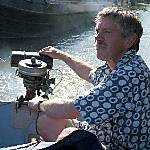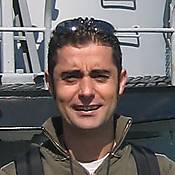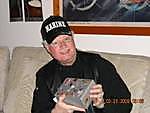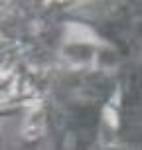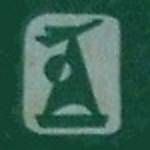You are viewing the archived version of the site.
Go to modelshipwrights.com for the current dynamic site!
Go to modelshipwrights.com for the current dynamic site!
1⁄350USS Lexington (CV2) 1927-1942
23
Comments
Stage 27: flight deck light AA positions
Scratch parts: 46
Time (including painting): 1.5 hours
Kit parts D6 and D7 were discarded and replacements made from scratch.


Above: Replacement 1.1-inch mounting splinter shields.
Stage 28: overall detailing
Kit parts: 12
PE parts: 185
Scratch parts: 72
Time: 37 hours
At a minimum, half of the time at this stage involved painting the details and detailed painting.
Outboard gallery support webs: support webs between the underside of the 20mm AA platform on the outboard side of the stack and the flight deck: the situation is rather complicated regarding these parts which are F31 and F32 in the kit and their corresponding GMM PE parts. Not surprisingly, since they are like-for-like replacements, the latter replicate the errors in the kit parts.
Essentially there were three types of web, which I will identify as (a), (b) and (c). Type (c) was a wide web with two vertical rows of lightening holes, as represented by parts F32. Type (b) was a narrower web than type (c), with a single row of vertical lightening holes, as represented by parts F31. Type (a) was narrower still, had no lightening holes, and is not represented in the kit. The sequence of these, from aft to forward, was: (b), (a), (c), (a), (c), (a).
When the AA platform was originally a boat platform there was a further web towards the fore end which was type (b). When the platform was converted to an AA platform, it was reduced in length at the forward end back to the position of the next type (a) web. The GMM PE parts were used as appropriate, with webs type (a) made from styrene sheet. I said it was complicated!

Above: Replacement support webs, left to right types b, a, c, a, c and a.
Chocks (fairleads): four were made up from strip styrene and mounted on the starboard deck edge adjacent to the aft end of the stack structure and also near the bridge.
Bits (bollards): a pair made from strip and rod styrene were mounted between the rear two chocks and well inboard between the stack and bridge.

Above: Chocks and bits at aft end of stack structure.

Above: Chocks, bits and cable reels around the bridge structure.
Large cable reels: the ones on the aft gallery decks were made up from the GMM PE set. Instead of inserting an axle and winding it with suitable line (as suggested by GMM), I took the easier and just as effective approach of simply sandwiching a short length of plastic rod of the appropriate diameter.
Small cable reels: the very nice cable reels supplied by GMM on their PE for installation below the lower AA platform on the outboard side of the stack are not needed. This is because they were for the boat falls for the boats stowed on the platform above. When this level was converted to an AA platform the boats and associated fittings, including the fall reels, would have been removed. However, three of them come in very useful for the same purpose with the small boats suspended from davits alongside the bridge. They are a little over-scale (particularly in the width through the axis), but not so much as notices. Any smaller and they would have been very difficult to construct.
Catwalk between radar cabin on fore edge of stack and rear of bridge: this was adapted from the kit part. Upper surface detail was removed and the sides filed down to make it narrower. At the forward end the ‘shoulders’ were filed to a curved profile. Two supporting brackets on the underside at the forward end were made from styrene sheet. Having run out of the thin brass wire I was using for such things, the supporting struts from the brackets down to either side of the rear edge of the lower bridge structure were made from stretched sprue. At a later stage, the compass on the catwalk was made from a small decorative bead and a piece of stretched sprue.


Above: Catwalk and bits (bollards) between bridge and stack.
Comments
Hi Joseph,
Yeah, it was a lot of research. I was DETERMINED to make it abolutely as accurate as possible. What I don't understand is how Trumpeter got so much of it grotesquely wrong. Anyway, thanks for your comments. I sure hope you find my feature useful - from what I've seen the 1:700 from Trumpeter is just a scaled down version of the 1:350 kit, including everything that's wrong with the big one!
JUL 08, 2008 - 05:36 AM
Hi Rui
Well, well, well. I used to be a graphic designer myself as well. And a copywriter. Hence what I hope is a deal of professionalism in my SBS guide.
The whole project spanned two years. I didn't dare start another model in all that time, knowing it would simply delay completion and possibly I would lose my motivation. Sometimes it was very hard to keep going - the progress when doing the armament and the air group seemed so slow. I really had to force myself to keep going.
Thanks for the advice on using Clearcoat on the decals. Actually, that is what I did use, in order to soften the decals so they would lay close on the curved fuselage sides, to get them to stick, and to try and dull them down. All the planes were matt varnished as well, but that still didn't kill the decal edge reflection.
You can see some of my 1:700 stuff at: LINK If you select my name from the top of the menu on the left you can see all my galleries.
By the way, the 1:700 Trumpeter Lexington looks like just a scaled-down version of the 1:350 version, including everything that is wrong and inaccurate. So please, please, do use all the research I did to get it right. I look forward to seeing the result!
Regards, Chris
JUL 08, 2008 - 05:48 AM
Jim
Your comments an honour indeed. I have followed your work over the years at Modelwarships.com and you really are the best. Counting the hours is actually a way of giving myelf a sanity check! Which is why to some extent the whole project took me two years from start to finish.
Regards, Chris
JUL 08, 2008 - 05:53 AM
Thanks for taking time to answer to my questions!
I have the 1/700 Trumpeter model, for Coral Sea fit, so I guess you have done all the research for me - but still, I have to get the work myself!
Not for now, but for a "near" future (I am currently working on three projects, one a full scratch all in 1/700).
Thanks for the link, and since my memory is better for graphics, than for names, I can say that I had already seen your Sara / Lex duo in MW.
Please keep up - keep your ship models afloat!
Rui
JUL 08, 2008 - 05:57 AM
Are you sure that thing is a model. It looks so real. In some of those photos it looks too real. Nice job. Amazinglly nice job. Great tribute to those who sailed, fought and died on board the original Lady Lex carrier. Nice work.
JUL 11, 2008 - 08:46 AM
Hi Chris,
Sorry no plans on any new 1/350 items.
You could use my YC-728 or 829 for an open ammunition lighter. I have some photos of their use as such.
JUL 15, 2008 - 07:06 AM
Hello Chris:
I just finished reading your build log. Outstanding work and very well written. I have this kit, not sure I want to tackle all the inaccuracies vice just building an OOB kit, but, your work is inspirational and you presented a lot of neat ideas to enhance the kit. I will be referencing your build log when I tackle mine. Thanks for posting and sharing.
FEB 10, 2015 - 08:49 AM
Mark, I doubt Chris will respond as this is a 7 year old tread and Chris last signed in 7 years ago.
FEB 10, 2015 - 09:13 AM
wow, awesome model building.
well worth resurrecting the thread and feature.
FEB 11, 2015 - 09:17 AM
Copyright ©2021 by Chris Smithers. _OPINIONS Model Shipwrights, KitMaker Network, or Silver Star Enterrpises. Images also by copyright holder unless otherwise noted. Opinions expressed are those of the author(s) and not necessarily those of Model Shipwrights. All rights reserved. Originally published on: 2008-07-04 00:00:00. Unique Reads: 23646






